The Vital Role of Sucker Rod Pump in Crude Oil Extraction Processes
The sucker rod pump is a pivotal technology in the oil and gas industry, playing a crucial role in the extraction of crude oil from underground reservoirs. As one of the most widely used artificial lift methods, the sucker rod pump has a long history of reliability and efficiency. This article explores the key components, working processes, advantages, and recent advancements in sucker rod pump technology, underscoring its significance in the oil and gas sector.
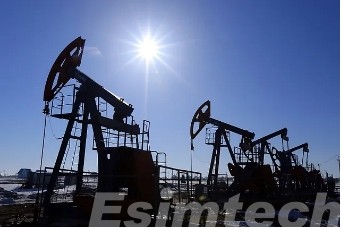
How Does a Sucker Rod Pump Work
The sucker rod pump operates on the principle of converting rotary motion from a surface engine into vertical reciprocating motion to lift oil to the surface. This process involves several key components, each playing a crucial role in the system’s overall functionality.
Key Components
1. Surface Unit
- Prime Mover: Typically an electric motor or an internal combustion engine that provides the power to drive the pump.
- Pump Jack (Beam Pump): Converts the rotary motion of the prime mover into the vertical reciprocating motion needed to operate the downhole pump. It includes components like the walking beam, pitman arms, and the Samson post.
2. Sucker Rod String
- A series of interconnected rods made from steel or fiberglass that transfer the reciprocating motion from the surface unit down to the pump located at the bottom of the well.
3. Downhole Pump
- Barrel: A cylindrical housing that contains the plunger and other internal components.
- Plunger: Moves up and down within the barrel, creating the pumping action.
- Valves: Check valves that regulate the flow of oil into and out of the pump barrel.
4. Tubing
- The conduit through which the lifted oil travels from the downhole pump to the surface.
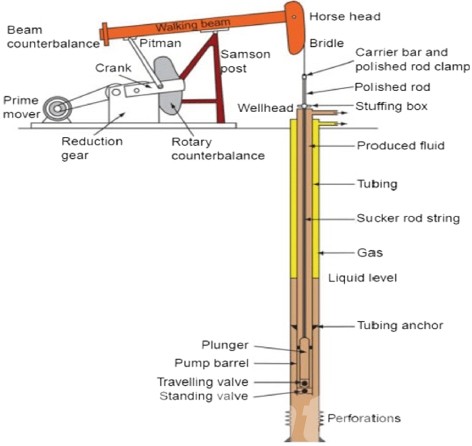
Working Process
The operation of a sucker rod pump can be broken down into the following steps:
1. Initiating Motion
- The prime mover drives the pump jack, converting its rotary motion into an up-and-down motion through the walking beam.
2. Transferring Motion
- The walking beam’s motion is transferred to the sucker rod string via the polished rod, which is connected to the horsehead of the pump jack.
3. Downhole Action
- The reciprocating motion of the sucker rod string drives the plunger up and down inside the barrel of the downhole pump.
4. Intake Stroke (Downstroke)
- As the plunger moves downward, the traveling valve (located at the bottom of the plunger) closes due to the pressure of the fluid column above it.
- Simultaneously, the standing valve (located at the bottom of the barrel) opens, allowing the fluid from the reservoir to enter the pump barrel.
5. Discharge Stroke (Upstroke)
- When the plunger moves upward, the standing valve closes, preventing the fluid from flowing back into the reservoir.
- The traveling valve opens, allowing the fluid to be lifted above the plunger.
- The fluid column above the plunger is lifted further up the tubing towards the surface.
6. Continuous Operation
- This cycle repeats continuously, with each upstroke and downstroke lifting the fluid incrementally towards the surface until it reaches the wellhead and is collected for processing.
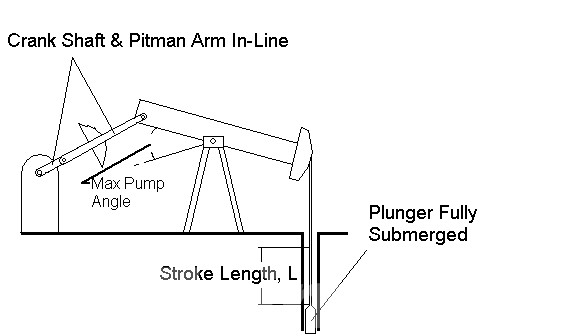
Efficiency and Optimization
To ensure optimal performance and efficiency of a sucker rod pump, several factors are considered:
- Stroke Length and Speed: The stroke length and speed are adjusted to match the well conditions and production rates.
- Pump Size: The size of the downhole pump is selected based on the well’s production capacity and fluid characteristics.
- Maintenance: Regular maintenance of the surface unit, sucker rod string, and downhole pump components is crucial to minimize downtime and maintain efficiency.
Advantages of Using a Sucker Rod Pump in the Oil and Gas Industry
This chart provides a concise overview of the key advantages offered by sucker rod pumps in the oil and gas industry, highlighting their reliability, efficiency, and adaptability
| Advantage | Description |
| Reliability | Sucker rod pumps have a proven track record of reliable operation, even in harsh environments. They can operate continuously with minimal downtime. |
| Versatility | Suitable for a wide range of well depths and production rates, making them adaptable to various oil field conditions. |
| Energy Efficiency | Modern sucker rod pumps are designed for efficient energy use, reducing overall lifting costs. Incorporation of technologies like Variable Frequency Drives (VFDs) further enhances efficiency. |
| Ease of Maintenance | The design allows for relatively straightforward maintenance and repair, minimizing downtime and associated costs. |
| Cost-Effectiveness | Generally, the initial and operational costs of sucker rod pumps are lower compared to other artificial lift systems. |
| Long Service Life | With proper maintenance, sucker rod pumps can have a long operational lifespan, providing consistent performance over time. |
| Enhanced Production Control | Advanced control systems and automation allow for precise control of production rates, optimizing oil extraction processes. |
| Corrosion Resistance | Use of advanced materials like high-strength fiberglass rods and corrosion-resistant alloys increases resistance to corrosive environments, extending component lifespan. |
| Adaptability | Can be used in wells with varying fluid compositions, including those with high gas-to-oil ratios or sand production. |
| Improved Pump Efficiency | Innovations in plunger and valve designs have increased the overall efficiency of the pump, ensuring more effective fluid displacement with less energy. |
| Real-Time Monitoring | Integration with real-time monitoring systems allows for continuous performance tracking and immediate adjustments, ensuring optimal operation. |
| Predictive Maintenance | Use of predictive maintenance technologies helps in anticipating and addressing issues before they cause failures, reducing unexpected downtimes. |
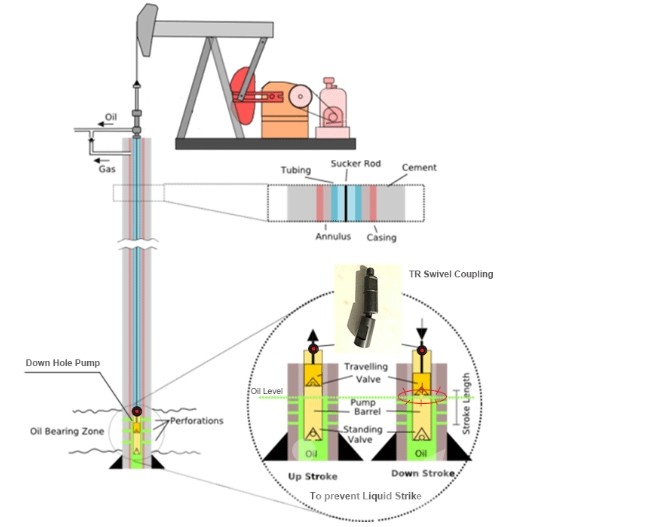
Advancements in Sucker Rod Pump Technology that are Transforming Oil Extraction Processes
Continuous innovation and technological advancements have significantly enhanced the performance, efficiency, and reliability of the sucker rod pumps.
1. Automation and Smart Technologies
Automated Control Systems
The integration of automated control systems has revolutionized sucker rod pump operations. These systems utilize sensors and digital controllers to monitor and optimize pump performance in real-time. Key advancements include:
- Real-Time Monitoring: Sensors continuously collect data on pump operations, well conditions, and fluid levels, enabling immediate detection of anomalies.
- Predictive Maintenance: Advanced algorithms predict potential failures before they occur, allowing for proactive maintenance and reducing downtime.
- Optimized Production: Automated systems adjust pump speed and stroke length based on real-time data, maximizing production rates while minimizing energy consumption.
2. Advanced Materials
High-Strength Fiberglass Rods
The use of high-strength fiberglass rods is becoming increasingly common, offering several benefits over traditional steel rods:
- Corrosion Resistance: Fiberglass rods are more resistant to the corrosive environments typical in many wells, leading to longer service life.
- Reduced Weight: Fiberglass rods are lighter than steel, reducing the load on the surface equipment and lowering energy consumption.
- Improved Flexibility: The flexibility of fiberglass reduces the likelihood of rod breakage, particularly in deviated or horizontal wells.
Corrosion-Resistant Alloys
Advanced alloys are being used for components exposed to corrosive fluids, extending the lifespan of pump components by resisting wear and corrosion. This reduces the frequency of replacements and maintenance, improving overall system reliability.
3. Enhanced Pump Designs
Plunger and Valve Innovations
Innovations in the design of plungers and valves have led to more efficient and reliable sucker rod pumps:
- Precision-Crafted Plungers: Modern plungers are designed with tighter tolerances and smoother surfaces, reducing friction and wear while improving pumping efficiency.
- Enhanced Valve Configurations: Improved valve designs, such as ball-and-seat or flapper valves, provide better sealing and reduce leakage, ensuring more effective fluid displacement.
Downhole Monitoring Tools
Advanced downhole monitoring tools provide valuable insights into well conditions, allowing for more precise control of the pumping process. These tools measure parameters such as temperature, pressure, and fluid composition, helping operators make informed decisions to optimize pump performance.
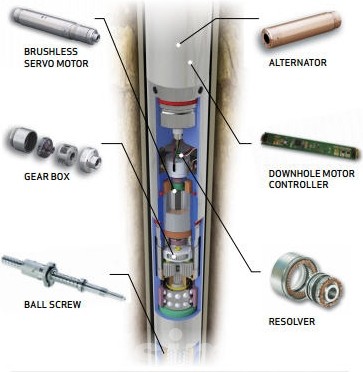
4. Energy Efficiency Improvements
Variable Frequency Drives (VFDs)
Variable Frequency Drives (VFDs) have been integrated into sucker rod pump systems to enhance energy efficiency. VFDs control motor speed based on real-time demand, offering several benefits:
- Energy Savings: By adjusting motor speed to match actual pumping requirements, VFDs significantly reduce energy wastage.
- Extended Equipment Life: Smooth motor startups and controlled speed variations reduce mechanical stress on equipment, extending its lifespan.
- Enhanced Control: VFDs offer precise control over pump operations, allowing for fine-tuning of performance parameters.
5. Digital Twins and Simulation
Digital twin technology creates a virtual replica of the sucker rod pump system, enabling operators to simulate various scenarios and predict outcomes without disrupting actual operations. Advantages include:
- Performance Optimization: By simulating different operating conditions in the oil and gas industry, operators can identify optimal settings for maximum efficiency and production.
- Failure Prediction: Digital twins help predict potential failures and implement corrective measures before actual issues arise.
- Training and Planning: Virtual models serve as effective training tools for new operators and assist in planning maintenance activities.
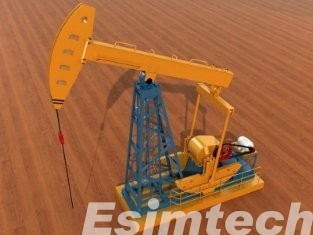
6. Enhanced Surface Units
Improved Pump Jacks
Recent developments in pump jack design have focused on enhancing durability and efficiency:
- High-Efficiency Gearboxes: Newer gearboxes are designed to minimize energy loss, increasing overall system efficiency.
- Robust Construction: Improved materials and construction techniques enhance the durability of pump jacks, reducing maintenance needs and extending service life.
7. Integrated Data Management Systems
Real-Time Data Analytics
Integration of advanced data analytics platforms allows for better decision-making and operational efficiency:
- Data Integration: Combining data from various sensors and control systems into a unified platform provides a comprehensive view of operations.
- Actionable Insights: Advanced analytics algorithms provide actionable insights, enabling operators to optimize performance and predict maintenance needs.
Conclusion
With its robust design, versatility, and recent technological advancements, the sucker rod pump plays a vital role in lifting crude oil from underground reservoirs, to meet global energy demands. As the oil and gas industry evolves, further innovations in sucker rod pump technology will undoubtedly enhance its performance and extend its applications.
